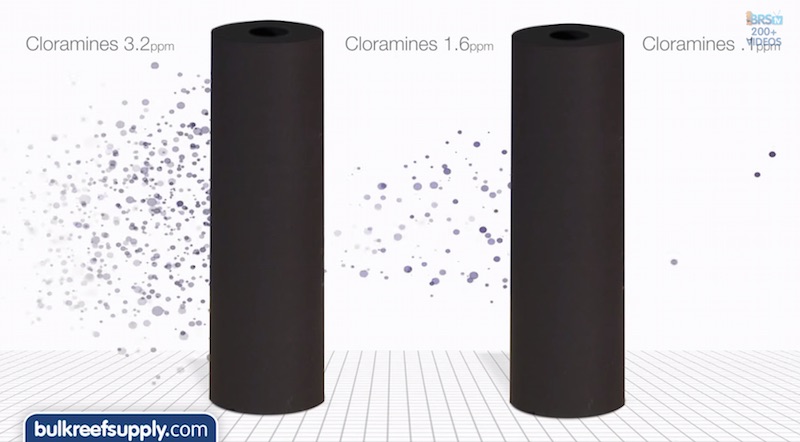Chloramine is a well-documented toxin to all manner of aquatic life, freshwater and marine, and aquarists have long believed that basic reverse osmosis is good enough to eliminate Chloramine from our water supply. Pre-treatment with carbon blocks and post-treatment with deionizing resins can remove some degree of chloramine from our tap water, but not all carbon blocks are created equal, not even close, and while DI resin will remove Chloramines it is also a very expensive way of dealing with this tap water treatment which is toxic to aquatic life.
In this investigative report by Bulk Reef Supply, they test a range of different carbon blocks for the efficacy at specifically eliminating the dreaded chloramine and they reveal that even 0.5, 0.6 and granulated catalytic carbon are borderline useless after just a couple hundred gallons of filtered water. The volume of filtered water is not the same as the volume of purified water that comes out of the reverse osmosis membrane as these membranes produce between 3 and 5 times more waste water than purified water, meaning that basic carbon blocks are really truly poor defenders against toxic chloramines.

Thankfully, the higher performing BRS Universal carbon block is specially designed for effectively removing Chloramine from filtered water before it hits the other stages of the water purification system, leading to greatly reduced levels of this toxins being pulsed into your aquarium system from top off water supply. Like the live rock porosity video BRS did several months back, this exposé of the issue of chloramine in tap water and “purified” water is very informative, and it includes many different ways for aquarists to manage chloramines.
Aquarists with “mystery” problems in their tanks who also have tanks that require lots of water to make up for evaporation will definitely want to take note of BRS’s findings to determine whether the dreaded chloramine could be a cause of their issues. Before you go all kamikaze on removing chloramine from your tap water, perhaps the first course of action would be to test your supply water and purified water for chloramines to determine if you have to deal with it in the first place, with LaMotte’s insta-test series being so easy and simple to use that you have no excuse not to.
Big props goes to Bulk Reef Supply for this insightful and revealing analysis of how reverse osmosis units actually deal with Chloramines, and the thoughtful and informative video they put together to inform the greater public.



